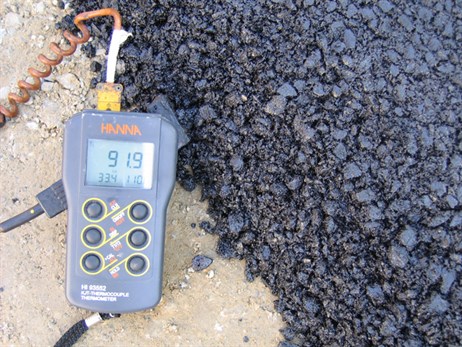
In September 2019, the UK’s All Party Parliamentary Group on Highways published a document urging road authorities to use more warm mix asphalt. “Over 300 UK councils…have declared climate emergencies. This publication is designed to encourage those authorities which have responsibility for highways to put their theoretical support for environmental measures into practice,” said chair of the Group, Christopher Chope MP in his foreword to the report.
Warm mix asphalt is asphalt that is produced and applied at temperatures between 20° and 40°C less than an equivalent hot mix asphalt. Reducing the amount of heat required means less fuel burned, less carbon dioxide produced and less cost. According to the report, the UK would save 61,000tonnes of carbon dioxide each year if it switched to warm mix from hot mix.
Lower working temperatures mean that fewer fumes are given off during the paving process which is better for the health of workers; roads are hard enough to take traffic sooner, reducing disruption to road users and congestion; workability and compaction can be improved.
The first warm mix technologies were developed by
Foaming techniques, of which there are several, lower the viscosity of the bitumen so that it can coat the aggregate at a lower temperature by introducing small amounts of water which then turns to steam and expands. Water can be introduced by injecting water into hot bitumen with nozzles, or by using zeolites, or hydrophilic minerals, or by using the moisture in sand by adding the sand at a later point into the hot bitumen.
Following on from the earliest warm mix technologies, and to avoid the need to invest in changes to asphalt plants, specialist began developing organic and chemical additives that could be added to the binder, allowing the same process as hot mix production, only at lower temperatures. Additives based on wax work by lowering the melting point of the bitumen. Chemical additives change the chemical reaction between the aggregate and the bitumen.
Initially, asphalt suppliers would dose mixes with the warmmix additive themselves at the plant, with demand shifting later to ask for bitumen already containing the additive, said Read.
US leads the way
Though warm mix was invented in Europe, it has been proven in the US. First used in the US in 2004, Departments of Transport (DoTs) soon recognised its cost benefits and began to mandate it.

The
Warm mix technology also allows asphalt to be hauled longer distances and can increase the paving season. For these applications, the mix may be produced at standard hot mix temperatures, cool as it is transported and then can still be compacted at lower temperatures.
The latest figures from the US’s
The most common technology for warm mix in the US is production plant foaming, accounting for 63% of the market. The use of chemical additives, such as
In Europe, the picture is different. The European Asphalt Pavement Association’s (EAPA’s) latest figures for 2017, show that France is the biggest user, with warm mix accounting for 11.4%, followed by Norway at 11.1% and Denmark at 8.5%. The UK’s
Sasobit, Sasol’s wax-based additive which it launched in 1997, is used all over the world, from airports in polar regions to roads in Africa, says Susann Gross-Matthaei, marketing and sales manager for asphalt additives, Europe at Sasol Wax. “Our biggest market is definitely Europe but we see that China and the US are catching up quickly over the years,” she says.
Recently Sasol launched a new version of its additive, Sasol Redux. “Sasobit gives all the benefits of warm mix and also deformation reduction, you make the whole system less flexible which is now always what people want,” explained Gross-Matthaei. “Redux is a light version of Sasobit that reduced the viscosity but not the deformation.”
Belgium, Scandinavia and the Netherlands are all growing markets for asphalt additive specialist
“Because you can extend the period of production and application of asphalt with warm mix, you can work during the winter and you can have longer hauling distances,” said Sangalli. “That’s important in countries such as Russia, Africa or South America where mixes may have to travel for three or four hours.”
In Switzerland, Iterchimica is working on projects which combine both warm mix technology and high proportions of recycled asphalt planings (RAP).The combination of warm mix and RAP can be a good one because one of the challenges in using RAP is that if the already-aged bitumen is heated too much, it of premature ageing and cracking.
Iterchmica’s Iterlow RS additive has been designed specifically for use with mixes containing RAP. By combining this technology with advanced mixing plants, Swiss companies are using 90% or even 100% RAP, said Sangalli.
“Road authorities must think about reusing asphalt and bitumen if they want to help the environment,” said Carl Robertus, technical director bitumen at Nynas. “At the moment there are still hurdles around how much can be recycled, with caps on the proportions of recycled materials used. Recycling can be both an environmentally and commercially sound way to work.
Robertus also highlighted the huge impact that durability makes on a road’s carbon footprint (see 'Beyond wam mix')
A healthy choice
Warm mix’s potential to create better working environments, around plants and when roads are laid, is growing in importance, particularly for policymakers in Europe. As well as creating cooler working conditions for those laying pavements, lowering the mix temperatures mean lowers fumes and odours by around 50% for every 12°C reduction in temperature.

Shell’s Read highlights this warning related to warm mix emissions though: “The one thing that is not reduced is particulate matter, it’s still given off,” he says. “That’s the reason we introduced Shell Bitumen FreshAir, which reduces particulate matter emissions, and other gases, by 40%, above what would be achieved with a warm mix binder.”
The UK report, referenced above, also makes the point that warm mixes have other safety benefits because they create less steam when laid, improving visibility for the workforce and passing traffic, particularly at night.
Given all the benefits that warm mix asphalt production offers, it seems puzzling that the US remains the only place where it is widely used. All the warm mix technologies are sufficiently advanced and have been put through their paces on numerous projects. “There is enough evidence out there to show that there is no negative impact on the performance of the asphalt,” said Read.
The issue is that unless road authorities ask for warm mix, it doesn’t make sense for road contractors to propose something different. “To produce asphalt at low temperatures means that the asphalt mix costs more because you have to treat it differently,” said Gross-Matthaei. “You either need to make a big investment in your mixing plant or buy additives that you add to the mix. At the moment, these additional costs are not covered in the tenders. As long as we have the mindset that the cheapest tender is getting the job, this is not going to change.”
“If you don’t put the requirement for these technologies in the specification, then obviously the contractors will go to the cheapest way possible,” agreed Sangalli.
In the UK, change is slow, said Dennis Day, technical support manager for Nynas Bitumen in the UK who has been involved in projects with both warm mix and cold mix for decades: “It’s quite a conservative market and changes take quite a long time to happen. We have been trying to change the market perception of warm and cold mix over the years in the UK.”
In those countries where warm mix is more widely used, change has come from the clients. In the US, DOTs were driven by the desire to cut costs. Norway saw a sharp rise in uptake when it incentivised the use of warm mix. Sweden and Netherlands are now looking at carbon cost as well as capital cost when assessing tenders. France is a slightly different case, since its higher use of warm mix dates back to a voluntary agreement between designers, contractors and maintenance firms in 2009 to promote the use of warm mix for the sake of the environment.
In the UK, there is finally a specification for warm mix. In July, Highways England updated its Specification for Highway Works, which must be applied to motorways and trunk roads, to include warm mix. Prior to that, contractors and suppliers had to apply for Departures from the specification, adding to paperwork and time. Combined with the All Party report, this should give road authorities the confidence to ask for more warm mix.










